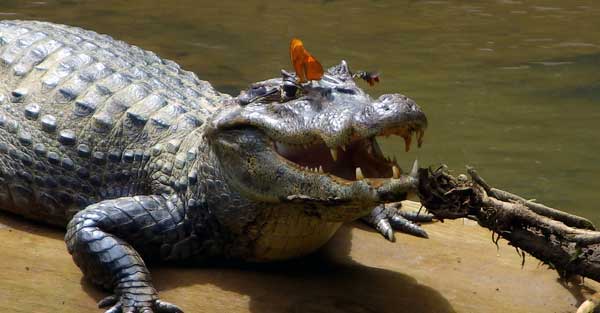
Crocodiles and alligators: They’re just like us! Well, not exactly. But lately the jagged-toothed semi-aquatic reptiles have been spotted “doing everyday tasks” just like the celebs in US Weekly. Here are some of the latest findings on the daily doings of these fearsome predators:
• They engage in neighborhood surveillance—by clambering up trees. “Extant crocodilians are generally considered to be predominantly or semi-aquatic,” writes zoologist Vladimir Dinets in the January 2014 issue of Herpetology Notes, and “are virtually never thought of as animals capable of climbing.” Except that some of them can. Dinets, of the University of Tennessee, and his colleagues in Australia and Gabon have compiled a list of observations of arboreal crocs. They include: American crocodiles (Crocodylus acutus) lying on aerial roots and branches of mangrove trees overhanging rivers in Costa Rica, Colombia, and Everglades National Park; and slender-snouted crocodiles (Mecistops cataphractus) in the West African country of Gabon scaling vertical river banks to bask on branches suspended over the water. Such tree lounging, the scientists speculate, may be driven by either thermoregulation (crocodiles must move around between warm and cold areas of their habitat to heat up or cool down) or “surveillance of the habitat.” These crocodiles, the researchers write, are looking out for lurking dangers “from a vantage point where escape is as easy as falling off a log.”
• They use tools. In an earlier study published in 2013, Dinets and his colleagues discovered that crocodiles balance sticks on their snouts to trick and capture prey, such as wading birds gathering twigs for their nests. Dinets, who had first observed this behavior in Indian mugger crocodiles (Crocodylus palustris), later carried out a systematic study of the American Alligator mississippiensis living close to bird breeding rookeries in Louisiana. They found a “significant increase” in stick-balancing behavior from March to May, when birds were building nests. Crocodiles “are typically seen as lethargic, stupid, and boring,” Dinets said, “but now they are known to exhibit flexible multimodal signaling, advanced parental care, and highly coordinated group hunting tactics.”
• They eat fruit and nuts. Steven Platt of the Wildlife Conservation Society and colleagues at the U.S. Fish and Wildlife Service have found that, in addition to consuming large quantities of mammals, birds and fish, crocodiles also have a fancy for “fleshy fruits.” Of 18 species of crocodilian studied—from the American alligator to the Nile crocodile—13 were found to eat some type of fruit, including berries, legumes, nuts, and grains. Because crocodiles range over large territories and excrete the seeds at some distance from the point of consumption, “our review strongly suggests that crocodilians function as effective agents of seed dispersal,” the authors write.
• They feed bees and butterflies with their tears. In an extraordinary observation, aquatic ecologist Carlos de la Rosa, director of the La Selva Biological Station for the Organization for Tropical Field Studies in San Pedro, Costa Rica, spotted a bee and a butterfly sucking tears from the eyes of spectacled caiman (Caiman crocodilus) basking on the banks of the Río Puerto Viejo last December. The insects, it seems, were likely siphoning scarce minerals and protein from the crocodile tears. And lest you assume that this is the sort of service only crocodiles provide, note that entomologists in Thailand have described worker bees drinking human tears, probably for their high protein content. “On man the bees were relatively gentle visitors,” the authors write, “mostly landing on the lower eyelashes from where they imbibed tears for 0.5–2.5 minutes, often singly but occasionally in congregations of 5–7 specimens per eye.”

